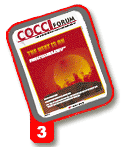COCCI FAQs
Frequently asked questions about cocci vaccination
Q. ARE POST-VACCINAL REACTIONS A CONCERN WITH COCCIDIOSIS VACCINATION?
A. Post-vaccinal reaction with
Coccivac vaccines have not been a
problem since the development of
spray cabinet technology, which
replaces application of the vaccine by
other routes such as spraying it on feed
or into the eyes.
Uniform coverage is important. If
some birds are missed by initial vaccination,
then other, unexposed birds
receive an uncontrolled shedding dose
of oocysts, which can result in insufficient
protection for some birds or strong
post-vaccinal reactions for others.
In the past, it was necessary to
administer amprolium after vaccination
to prevent excessive oocyst shedding
and post-vaccinal reactions that might
occur as a result of uneven coverage.
In addition, birds that did not receive a
full dose of the vaccine were exposed
to sporulated oocysts from the litter
and didn't always achieve their full
weight or performance.
The spray cabinet has changed all
that by providing more uniform vaccine
coverage, which has led to better
protection. With the spray cabinet, 100
chicks at a time are placed in a box and
misted with vaccine solution. It is
believed that after spraying, the chicks
preen and ingest the vaccine orally,
which results in more uniform administration
throughout a flock.
With uniform application, complete
protection is achieved within 28 days
and there is no need to use amprolium
after vaccination. Studies have shown
that weight gain and feed conversion in
birds vaccinated against coccidiosis via
spray cabinet administration is comparable
to that among birds receiving
conventional, in-feed ionophores.
Q. ARE BROILER CHICKS VACCINATED FOR COCCIDIOSIS MORE SUSCEPTIBLE TO COLONIZATION OF SALMONELLA ENTERITIDIS?
A. No. A recent study in Brazil by
Instituto de Biociências "� UNESP with
120 broiler chicks showed that vaccination
with Coccivac-B has no bearing on
the colonization or longevity of
Salmonella enteritidis (Se) in the gut.
The birds were divided into six
groups: Group 1 received the probiotic
ACM (anaerobic cecal microflora) by
spraying after vaccination against coccidiosis
and challenge with Se; Group 2
received ACM by intra-esophageal
inoculation after vaccination against
coccidiosis and challenge with Se;
Group 3 received ACM in drinking
water after vaccination against coccidiosis
and challenge with Se; Group 4
was not treated with ACM but vaccinated
against coccidiosis and challenged
with Se; Group 5 was not treated with
ACM or vaccinated, but challenged
with Se; and Group 6 was not treated or
vaccinated and not challenged (negative
control). The colonization of the
digestive tract, the presence of Se in
feces, and body weight were determined
2, 7 and 12 days after challenge.
Se count in feces and cecal colonization
were reduced in the ACMtreated
groups (1-3), mainly those
receiving ACM by spraying and intraesophageal
inoculation. This indicate that the actions of ACM
against cecal colonization
and fecal excretion of Se are
not affected by the use of a
vaccine against coccidiosis in
broiler chicks. Furthermore,
it suggests that ACM and
coccidosis vaccine can be
used together without reducing
the effectiveness of ACM.
An increase in cecal colonization
and fecal excretion
of Se was observed in the
groups not receiving ACM,
regardless of whether they
received coccidiosis vaccine.
Source: CocciForum Issue No.3, Schering-Plough Animal Health.







